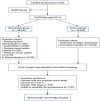Dietary Omega-3 intake may slow prostate cancer progression and reduce mortality risk: evidence from prostate, lung, colorectal, and ovarian cancer screening trial
- PMID: 40761352
- PMCID: PMC12318741
- DOI: 10.3389/fnut.2025.1623295
Dietary Omega-3 intake may slow prostate cancer progression and reduce mortality risk: evidence from prostate, lung, colorectal, and ovarian cancer screening trial
Abstract
Background: Prostate cancer is the second most prevalent malignant cancer globally and the fifth leading cause of cancer-related mortality. Omega-3 PUFAs [including eicosapentaenoic acid (EPA), docosapentaenoic acid (DPA), and docosahexaenoic acid (DHA)] may mitigate prostate cancer risk through various molecular mechanisms, such as inhibiting pro-inflammatory eicosanoid production via COX-2 pathway, regulating apoptosis and autophagy, and potentially influencing other signaling pathways like NF-κB. However, existing studies have reported inconsistent findings regarding the effects of Omega-3 fatty acids on prostate cancer, and there is limited large-scale longitudinal data exploring the dose-response relationship.
Methods: This study utilized data from the Prostate, Lung, Colorectal, and Ovarian (PLCO) Screening Trial to investigate the associations between Omega-3 (EPA, DPA, DHA) intake from dietary sources and the risk of prostate cancer and mortality. Omega-3 fatty acid intake was assessed via the Dietary History Questionnaire (DHQ). Multivariate Cox proportional hazards regression models, adjusted for key confounders including age, race, BMI, family history, PSA levels, comorbidities, and lifestyle factors, were employed alongside restricted cubic spline (RCS) analysis to account for potential confounding factors. A total of 30,552 male participants aged 55-74 years were included, with a median follow-up time of ≥7 years.
Results: The results indicated a linear relationship between Omega-3 fatty acid intake and the overall risk of prostate cancer (HR for highest vs. lowest quintile: 0.90, 95% CI: 0.81-1.00, P = 0.053). For prostate cancer mortality, a non-linear relationship was observed (P non - linearity = 0.009). The risk of death decreased as intake increased below 0.4 g/d, with a hazard ratio of 0.67 (95% CI: 0.49-0.91, P = 0.011) for the second quintile compared to the lowest quintile. However, intake exceeding this threshold was associated with an increased risk (HR for highest quintile: 0.70, 95% CI: 0.52-0.95, P = 0.021). The RCS analysis revealed a potential U-shaped association for mortality risk, with the lowest risk corresponding to an intake range of ~0.15-0.40 g/d.
Conclusion: Increased dietary intake of Omega-3 fatty acids has been associated with a reduced risk of prostate cancer. However, the association with mortality risk showed a threshold effect, with intakes below 0.4 g/day reducing mortality and higher intakes potentially increasing risk.
Keywords: Omega-3; diet; docosahexaenoic acid; docosapentaenoic acid; eicosapentaenoic acid; prostate cancer; restricted cubic spline.
Copyright © 2025 Shu, Lin, Yao, Liu, Chen, Wang and Wang.
Conflict of interest statement
The authors declare that the research was conducted in the absence of any commercial or financial relationships that could be construed as a potential conflict of interest.
Figures


Similar articles
-
Effects of a gluten-reduced or gluten-free diet for the primary prevention of cardiovascular disease.Cochrane Database Syst Rev. 2022 Feb 24;2(2):CD013556. doi: 10.1002/14651858.CD013556.pub2. Cochrane Database Syst Rev. 2022. PMID: 35199850 Free PMC article.
-
Selenium for preventing cancer.Cochrane Database Syst Rev. 2018 Jan 29;1(1):CD005195. doi: 10.1002/14651858.CD005195.pub4. Cochrane Database Syst Rev. 2018. PMID: 29376219 Free PMC article.
-
Effectiveness and safety of vitamin D in relation to bone health.Evid Rep Technol Assess (Full Rep). 2007 Aug;(158):1-235. Evid Rep Technol Assess (Full Rep). 2007. PMID: 18088161 Free PMC article.
-
[Volume and health outcomes: evidence from systematic reviews and from evaluation of Italian hospital data].Epidemiol Prev. 2013 Mar-Jun;37(2-3 Suppl 2):1-100. Epidemiol Prev. 2013. PMID: 23851286 Italian.
-
Screening for prostate cancer.Cochrane Database Syst Rev. 2013 Jan 31;2013(1):CD004720. doi: 10.1002/14651858.CD004720.pub3. Cochrane Database Syst Rev. 2013. PMID: 23440794 Free PMC article.
References
-
- Leslie SW, Soon-Sutton TL, Skelton WP. Prostate Cancer. In: StatPearls [Internet]. Treasure Island (FL): StatPearls Publishing; (2025). - PubMed
-
- Ubago-Guisado E, Rodríguez-Barranco M, Ching-López A, Petrova D, Molina-Montes E, Amiano P, et al. Evidence update on the relationship between diet and the most common cancers from the European Prospective Investigation into Cancer and Nutrition (EPIC) Study: a systematic review. Nutrients. (2021) 13:3582. 10.3390/nu13103582 - DOI - PMC - PubMed
LinkOut - more resources
Full Text Sources
Research Materials
Miscellaneous

